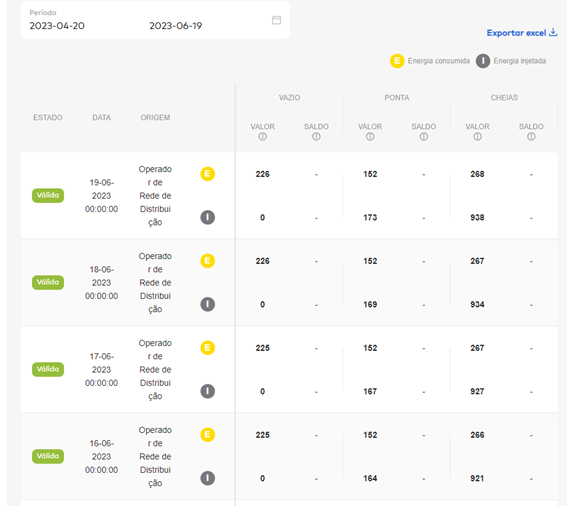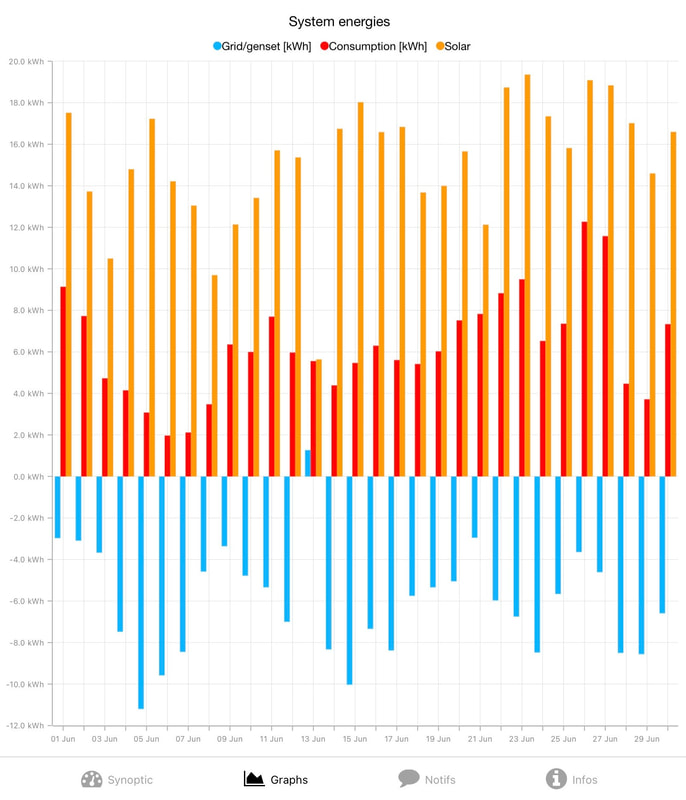|
Hello, Harold here. My previous post discussed the logistics needed to install solar panels at our home. This one looks at what it takes to sell whatever excess energy you generate. Yes, in Portugal someone will pay you for the energy you’re generating. There are many steps necessary to get to that point, and as usual I ended up doing some things out of order which resulted in some unnecessary delays. But now I think about those sunny days when the batteries are full and the excess energy the panels are generating are not wasted, but flowing back to benefit Portugal’s Green Energy initiative. Here are those steps: Potência: First thing you need to do is to review the potência, the amount of power you have contracted for with your electrical company. Ours was set the same as the previous owners of the house and was far above what we needed. There is no point contracting for a greater amount of power than you will use because it is just unnecessary expense. With the combination of the solar system and the fact we are retired, we can concentrate our electric usage during those times we have sun and full batteries, thus requiring less electricity from the grid. Also, by signing up at the e-Redes site, you can get a chart of your power usage so you have a better handle on the amount of power actually needed. Be aware, regulations prohibit you from changing your rate plan or potência more than once per year so make sure you have a good feel of your peak usage during both the summer and winter months. Rate Plan: We use a Bi-horária Diário which separates our usage into Vasio (off-peak) and Fora de Vazio (peak) for billing. Off-peak is during the week, and from the hours of midnight to seven a.m. Our household usage is very low during these times so we normally source our electricity from batteries. If our batteries are low because the skies have been cloudy, we can set our dishwasher to run overnight to use the off-peak rate. Usually we run the dishwasher and wash clothes during the day when it is sunny. When the weather is hot, we often run the mini-splits in the bedrooms in the late afternoon to cool down those rooms. Removing the heat is another form of energy storage rather than having to cool down a hot room with purchased energy. Even though we sell our excess energy, the price paid is quite low so it is better to use it. We are paid 0.06€/kWH (currently about 6.5 cents USD) for our excess but purchased power is 0.18€/kWH at peak (19.6 cents). Even off-peak is 0.08€/kWH (8.7 cents) if we buy it so it is much better to use the energy than to sell it. There are different rates for the weekends with more off-peak hours on Saturday and off-peak all day on Sunday. There is also a Tri-horária rate plan that includes some peak-hour billing during certain times of the day, but this generally corresponds to times when we have solar energy and to me was not compelling to use it. With solar, potência is the biggest part of our bill during most months of the year. System Registration: Prior to doing any sales of excess power, it is necessary to register the system on DGEG Portal. This is normally done by the installer but they will need the following information: - Photographs of the entire installation - Last electricity bill - Portuguese mobile number to enter in your system registration on the DGEG portal - Photograph of the inverter's serial number We are fortunate that our hybrid system has all the internal controls to support grid power injection. Some systems will require additional components and controls to be installed before putting energy back into the grid. If you are still in the process of installing your system and contemplating selling your excess power, make sure your installation includes all the components necessary for grid injection. After the system is registered with DGEG, you will receive a Recibo de Submissão which will have your consumer and producer CPEs (in essence information as where your panels are located). Smart Meter Installation: After your system is registered, e-Redes will contact you about doing a site-visit to evaluate your meter. If necessary, the meter will be exchanged with a bi-directional meter free of charge. The meter installed will automatically record your usage and you will be notified when it is no longer necessary to take your own meter readings. Since we are in the country, our meter has a cellular system that updates both the consumption and production readings every day at midnight. After the smart meter has been installed, you will need to contact your solar installer to have them remove the zero-feed and start delivering the excess power to the grid. You can then register at e-Redes at: https://balcaodigital.e-redes.pt/ Here you will be able to monitor your consumption and injection. It is a good idea to track these readings as once our meter stopped reporting readings and we needed to contact e-Redes to get it fixed. You can track your usage and the energy injected on the Consultar Históricos report below: You will see that in June we have very little energy consumption (C in the above table) and we are injecting quite a bit of energy into the grid (the I field in the table.) As seen above, on sunny days we commonly inject 7kWh or (much) more into the grid daily. Here's our Studar graph for the month of June showing our energy usage. The Orange is the solar being generated by the panels. The Red is our electrical usage and the Blue is the amount we re-selling back to the grid. As you can see, we generate a lot of excess solar energy during the summer. Taxes: You will need to contact Finanças and open an activity with a CAE code of 35113 (solar energy production) so you can report the income from your solar sales. Don’t be concerned as there will be no tax due unless you make over 1,000€ per year from your solar sales which is not likely to happen with a residential solar system. You will more likely receive something on the order of 10€/month. We had our accountant do this for us as there were a lot of questions that we just didn’t know how to answer. It only took him about 5 minutes to open the activity. Once we had the activity, we could contact a broker to purchase our power. Choose a Broker: We use Energia Simples for our energy sales and we still use EDP as our main energy supplier. It is not necessary to change suppliers or have the same company as your supplier and broker. It is necessary to initiate a contract with your broker, provide them with a signed contract, your Activity Declaration and a signed Power of Attorney. It takes several months for the contract to be finalized so start as early as you can. Once the contract has been finalized, your broker will send you their NIF (fiscal number) and then you need to go to Finanças site and designate the broker for an Autofacturação (self-billing) agreement. On the site, the section you need to fill out is “Comunicação de Séries de autofaturação com acordo” which will allow your broker to send the auto-billing statements. This is a little hard to find, but look under Todos os Servicos and search for Séries Documentais, then click Comunicação de Séries Documentais. The broker will send you instructions on how to do this. The broker will be able to determine your energy injection using the production CPE. It is not necessary to collect any data as it is all done automatically. This is the reason why it is a good idea to occasionally check if the readings are coming through on the e-Redes site in the Consultar Históricos section of the website. Getting Paid: After several months, usually once a quarter, you will receive an e-mail that indicates the amount of earnings. This is the result of the auto-fatura and is an automatic invoice for your power sales that quarter. Ours comes about three weeks after the close of the quarter. About the first of the following month you will get an e-mail that includes a SAF-t file. With this file, you go into Finanças, go into the Commercial area (Commerciante) and go to the Enter Invoice, (Enviar Fichero SAF-T(PT)), and enter the year, month and SAF-t XML file you received from the broker. You will receive the amount from the broker as a direct deposit to your bank account after another month. There are a lot of delays between the end of the sales period and the time you get your money. In Conclusion: Those are the steps we went through to get paid for our excess energy. As we stated in an earlier blog, this is not going to be a money-making scheme for us and we are not likely to ever pay back our investment. The system allows us peace of mind as we have a backup power source in the event of grid failure, which happens every now and then in the country. We also expect that someday when we sell the house, the system will definitely increase the value of the property. And, in our own way, we’re helping Portugal become energy independent. Comments are closed.
|
Your HostsHarold is a former software engineer. Jana is an author. Together they're exploring their new life in Portugal. Archives
December 2022
Categories
All
|



 RSS Feed
RSS Feed